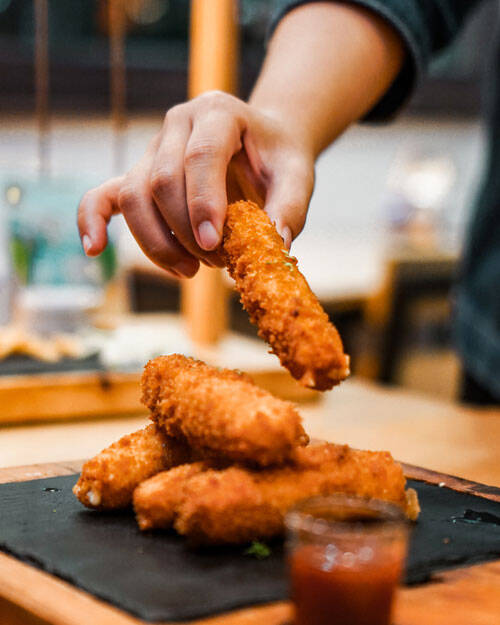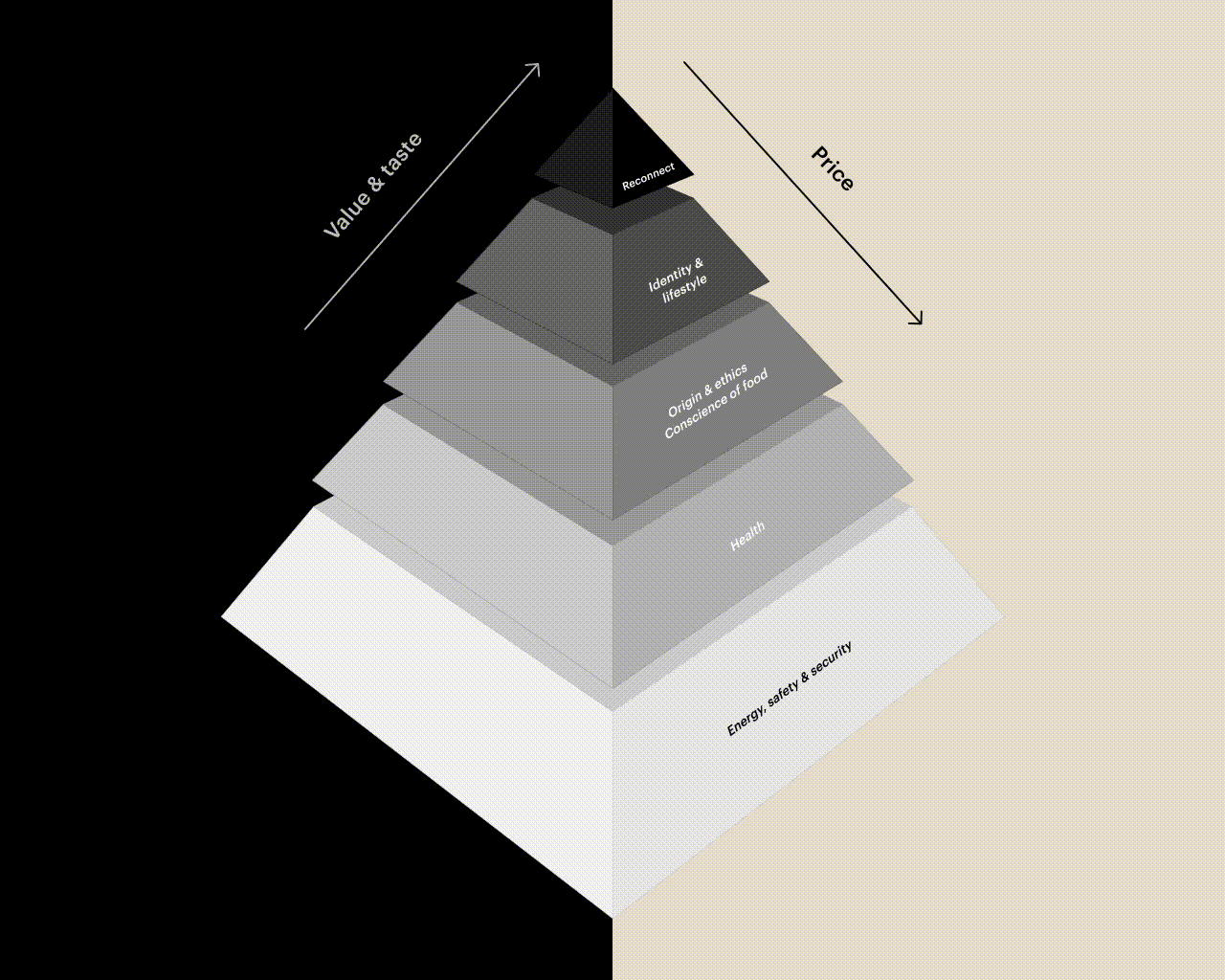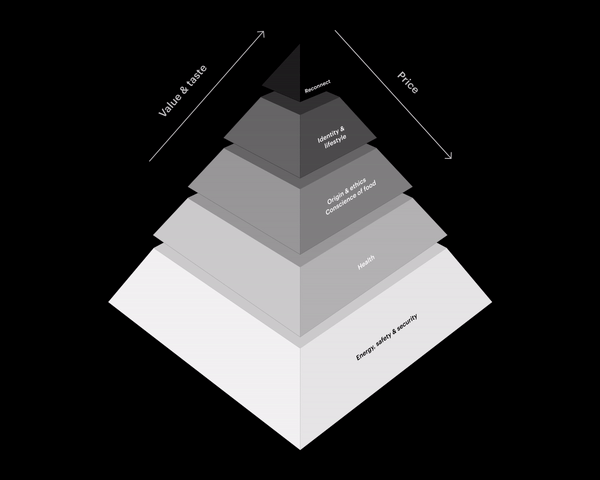3 min
“
Chefs are the standard bearers of the new way to eat.”
2025 onwards
2025 onwards
2022-2024
2022-2024
2020-2021
2020-2021


COVID-19 helped us taking a step back so we can take two steps forward later. The evolution of our food system towards a standard of health and sustainability will be confronted with hedonism fed by stressful and uncertain times. But once the virus is under control, the top layers of the pyramid will be embraced on an unprecedented scale. Healthy and sustainable food is set to finally become the new mainstream.

Phase 3: Planet-friendly and healthy
In the third phase we will see healthy and sustainable food choices hit the mainstream. More and more flavorful alternatives to meat may hit the market. Planet-friendly eating will become an acknowledged thing. Blended products mixing animal and plant protein may grow in popularity. Schools may start to implement healthy offerings as a new standard. Educational programs on food culture, backed by the United Nations and the World Health Organizations, will be developed and implemented around the world.
Chefs are the standard bearers of the new way to eat. Of course there will still be room for hedonism, but the new generations realize that there are planetary limits to our consumption. This will be the age of limited possibilities. Carbon pricing may be a reality. True cost accounting can be standard practice. We may be forced to change in the face of an ever more extreme climate.
Phase 2: Rise of new narratives
During the second phase we will see the rise of the new narratives. The top four layers of the pyramid find their way back into our lives, along with the realization that food should be good for people and the planet. More than ever we may see that our food choices make us more susceptible to diseases.
The hidden costs of our unhealthy lifestyle will become clear and companies and governments alike will know that healthy menus will need to be strongly encouraged. Fiscal measures to make healthy food more affordable, or unhealthy ultra processed food more expensive, will start to appear in progressive countries and states. The market may turn out to be incapable of transitioning towards a better system on its own. What we may see are businesses not just offering healthy menus to their employees, but contractually requiring those employees to make an effort to live a healthy life.
Technology can help track biometric data and make it easier for consumers to make healthier choices. Governments may begin to restrict advertisements for unhealthy foods and drinks. More restaurants will work with fresh, local ingredients and won’t want to depend on products from far away. The vital place that restaurants have in local economies may be recognized by local governments, whom will in turn try to encourage local sourcing. The realization that the global meat consumption negatively affects global biodiversity and greatly contributes to climate change may regain steam.


Phase 1: Temporary hedonism
The first phase will be defined by temporary hedonism. Stress and uncertainty have a measurable impact on the way we eat. People may shy away from the new and experimental and choose the reliable, safe, and comforting food options. Diets will be temporarily fridged. Meat, fat, salt, sugar: ingredients at home on the bottom layer of the food pyramid will surge in popularity. These are the foods we find in supermarkets and the American fast food restaurants as we saw them appear after the second world war. The burgers, pizza, fried chicken, hotdogs or similar ultra processed foods. The menus filled with comfort food will be the most popular.
Hans Steenbergen Xiao Er Kong
Recovery in three phases
Our food system is in flux right now. Food security, food safety, and sustenance is vastly more important than it was even a few months ago. The other layers, the higher values in our food as described in our Foodlov pyramid, are taking a backseat. For now. Eventually there will be an even greater emphasis on food that is sustainable, healthy, and good for everyone. But that will take time. Food Inspiration expects three phases of recovery from 2020-2025.
The flux of the food system for the coming years
TRENDWATCH

RECOVERY IN THREE PHASES

COVID-19 helped us taking a step back so we can take two steps forward later. The evolution of our food system towards a standard of health and sustainability will be confronted with hedonism fed by stressful and uncertain times. But once the virus is under control, the top layers of the pyramid will be embraced on an unprecedented scale. Healthy and sustainable food is set to finally become the new mainstream.

2025 onwards
Phase 3: Planet-friendly and healthy
In the third phase we will see healthy and sustainable food choices hit the mainstream. More and more flavorful alternatives to meat may hit the market. Planet-friendly eating will become an acknowledged thing. Blended products mixing animal and plant protein may grow in popularity. Schools may start to implement healthy offerings as a new standard. Educational programs on food culture, backed by the United Nations and the World Health Organizations, will be developed and implemented around the world.
Chefs are the standard bearers of the new way to eat. Of course there will still be room for hedonism, but the new generations realize that there are planetary limits to our consumption. This will be the age of limited possibilities. Carbon pricing may be a reality. True cost accounting can be standard practice. We may be forced to change in the face of an ever more extreme climate.

2020-2021
Phase 2: Rise of new narratives
During the second phase we will see the rise of the new narratives. The top four layers of the pyramid find their way back into our lives, along with the realization that food should be good for people and the planet. More than ever we may see that our food choices make us more susceptible to diseases.
The hidden costs of our unhealthy lifestyle will become clear and companies and governments alike will know that healthy menus will need to be strongly encouraged. Fiscal measures to make healthy food more affordable, or unhealthy ultra processed food more expensive, will start to appear in progressive countries and states. The market may turn out to be incapable of transitioning towards a better system on its own. What we may see are businesses not just offering healthy menus to their employees, but contractually requiring those employees to make an effort to live a healthy life.
Technology can help track biometric data and make it easier for consumers to make healthier choices. Governments may begin to restrict advertisements for unhealthy foods and drinks. More restaurants will work with fresh, local ingredients and won’t want to depend on products from far away. The vital place that restaurants have in local economies may be recognized by local governments, whom will in turn try to encourage local sourcing. The realization that the global meat consumption negatively affects global biodiversity and greatly contributes to climate change may regain steam.

2022-2024
Phase 1: Temporary hedonism
The first phase will be defined by temporary hedonism. Stress and uncertainty have a measurable impact on the way we eat. People may shy away from the new and experimental and choose the reliable, safe, and comforting food options. Diets will be temporarily fridged. Meat, fat, salt, sugar: ingredients at home on the bottom layer of the food pyramid will surge in popularity. These are the foods we find in supermarkets and the American fast food restaurants as we saw them appear after the second world war. The burgers, pizza, fried chicken, hotdogs or similar ultra processed foods. The menus filled with comfort food will be the most popular.
Hans Steenbergen Xiao Er Kong
Our food system is in flux right now. Food security, food safety, and sustenance is vastly more important than it was even a few months ago. The other layers, the higher values in our food as described in our Foodlov pyramid, are taking a backseat. For now. Eventually there will be an even greater emphasis on food that is sustainable, healthy, and good for everyone. But that will take time. Food Inspiration expects three phases of recovery from 2020-2025.
Recovery in three phases
The flux of the food system for the coming years
3 min








